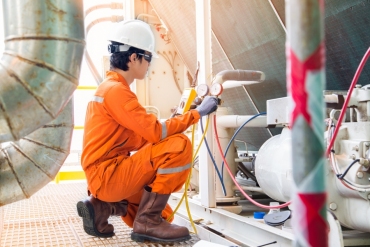Water plays a crucial role in power generation plants that need water in large quantities, particularly for cooling systems. The estimate of cooling fresh water is the total withdrawal s 3 to 4 percent and that is equal to per day to 3.9 billion gallons. There is also the discharge of power plants water that cannot be used.
The industrial cooling system for generating electricity and cooling the power plants include options:
- The cooling systems use river, lake or ocean to withdraw water to extract waste heat from the cycle of steam and this is then returned to the water body with trivial elevated temperature.
- Dry cooling systems condense steam using air. This is piped to air-cooled condensers from the turbine. The systems of dry cooling save water and the wet cooling systems initial cost is around three to five times, while the power required to operate the cooling fans and pump systems are nearly 1.5 to 2.5 times more than the wet cooling systems.
- Hybrid cooling systems put together wet and dry loops to cool re-circulating condenser water. Thus they reduce the volume of cooling water systems during hotter periods with wet cooling and in cooler periods with dry cooling as dry systems are unable to uphold low level exhaust pressure of the turbine.
EPRI’s Technology Program
EPRI’s technology program of water management evaluates reliability, operability, cost and performance of the advanced technologies of industrial cooling system. This is designed to minimize the implant on the thermal efficiency of the plant by reducing the water consumption and withdrawal. These techniques of cooling water are worldwide applicable. The program evaluates, identifies and demonstrates reliable and cost-effective treatment restricting the discharged pollutants from power plant.
Advanced cooling systems
Today, the electric power industry is used in various areas and this includes cooling water discharge and heat transfer treatment. Generally, research is focused on the technology ends. The government, universities, EPRI technology and national labs conduct basic research on the breakthrough of these technologies. Conversely, the private sector is demonstrating the technologies to commercialization.
Industrial cooling towers
The cooling towers are typically used in the process and industrial applications to eliminate the heat from the processes that involves generating heat, materials or machinery that are heated and need cooling.
The industrial cooling towers are referred to as cooling tower and this is used mainly to remove the heat and to re-circulate the cooling water systems that are used in refineries, petrochemical plants, power stations, processing plants of natural gas, beverage and food processing and in many more industrial facilities.
In fact, the cooling tower in the industries dissipates in the atmosphere the unwanted heat. It is an effective technique of cooling than water. Actually, the evaporative cooling process water cannot be used again, while under certain situations, only the surface cooling water is applicable.
The cooling towers are widely used in the process and power generation of large industries and this is the reason that the coal-fired and nuclear power stations are usually located near the sea so that the sea water systems are used for cooling as the primary source.

